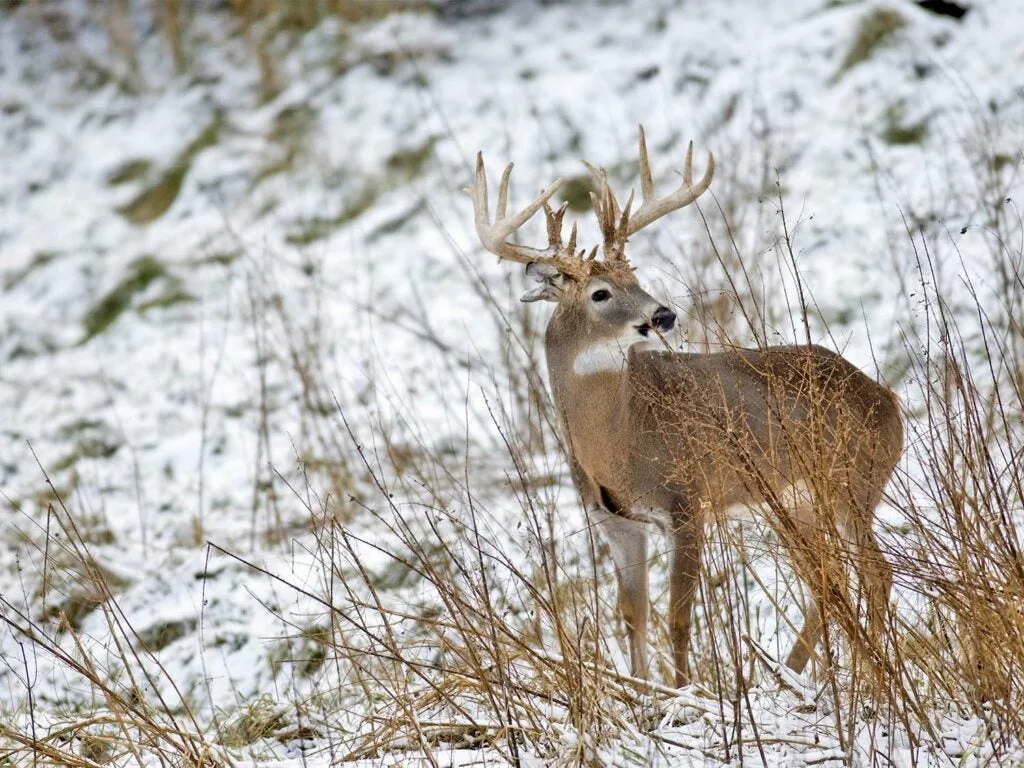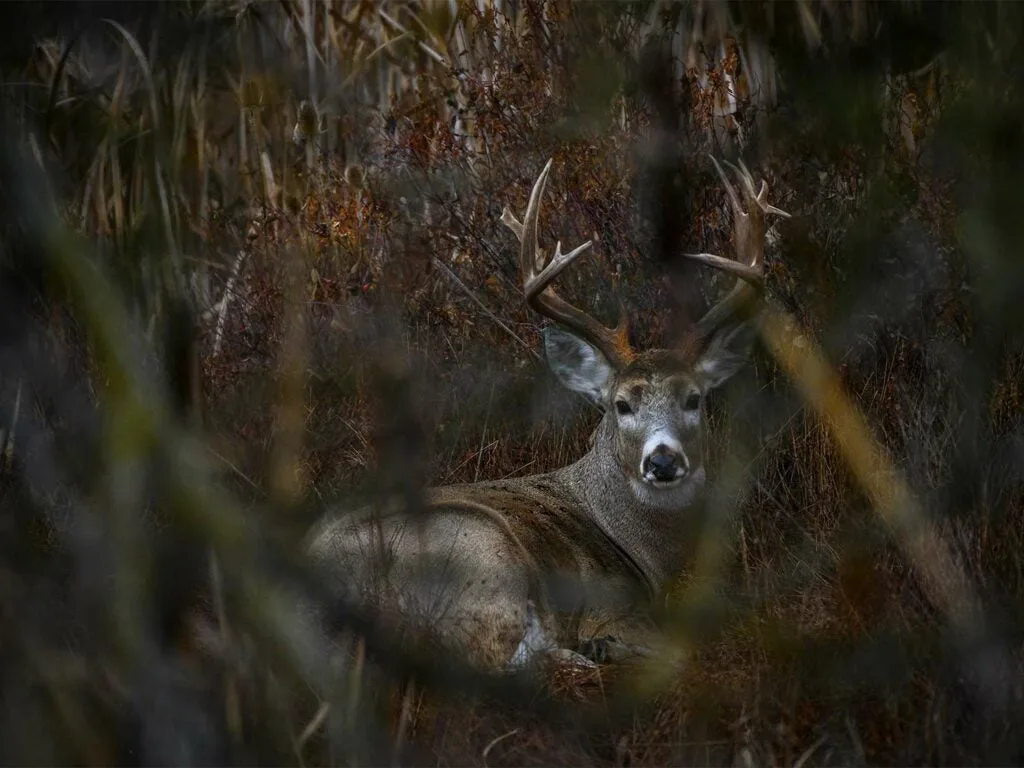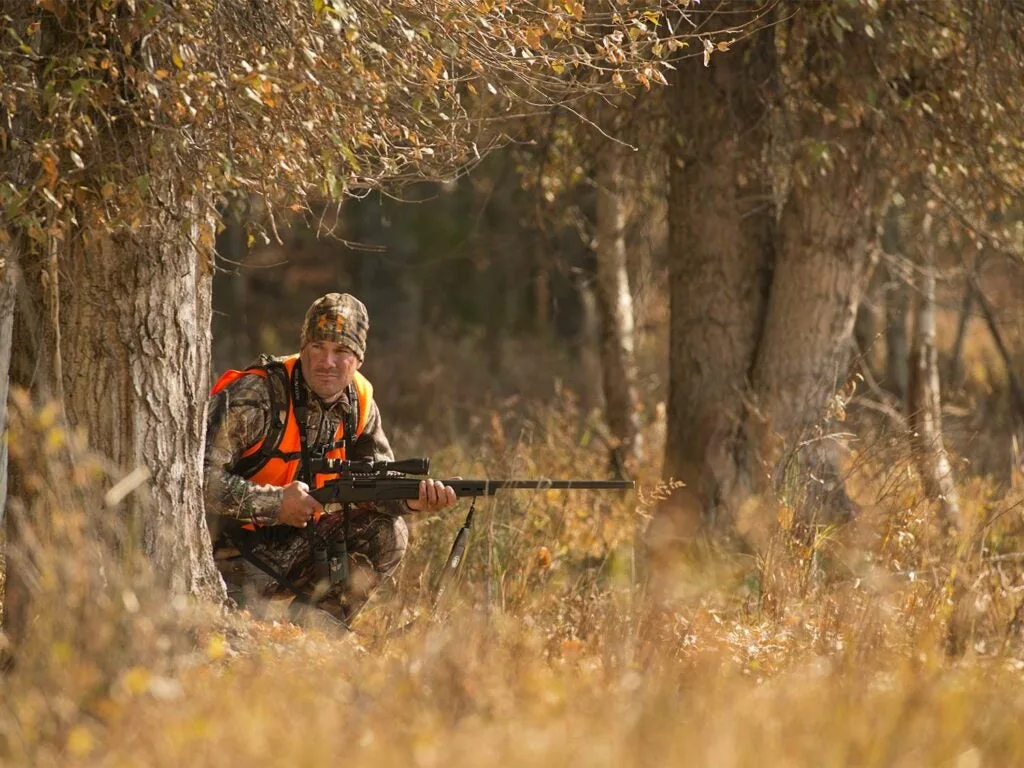
A huge non-typical buck makes a rare daylight appearance. John Hafner Photography
“What deer is that?” said Keith Chaffin, outfitter on the Junco Ranch in South Texas—the same ranch where Lyndon Johnson used to chase whitetails. He adjusted the spotting scope for a closer look. “He’s got great mass and main beams. He’s real old. Where has he been?”
Chaffin had intimate knowledge of the deer on the Junco. He did helicopter surveys and scouted year-round. Indeed, sitting in the tower stand with me, he could recognize and had even assigned names to most of the 10 bucks that had come out of the brush just before dark. Except for this one, which had Chaffin perplexed and not a little excited.
It was too dark and too far for a shot. But the next day, after searching, glassing, walking, and rattling, followed by a long, dusty stalk through thorn- and cactus-strewn brush, I caught up with and killed that barrel-chested 8-pointer as it crossed a sendero hot on the trail of an estrous doe.
Somehow, in spite of all the intensive scouting, hunting, filming, and aerial surveys, this buck had lived out its life cryptically, reaching the ripe age of 7-1/2 years without anyone’s knowing it was there. And this buck stood out. The main beams were over 2 feet long and the base measurements were 5-1/2 inches, and two long kickers gave it a score just shy of 150.
Call Them Superbucks
Every year across whitetail range, hunters kill huge old bucks that no one knew were around. On Texas ranches such as the Junco, where bucks are counted and cataloged; on crowded public land in the Northeast, where hunters seem to scour every square foot of the habitat on a daily basis; on 100-acre woodlots, where any rack buck would be considered a trophy, monsters turn up that had given no previous clues to their existence. These superbucks—mammoth, often nontypical, gnarly-racked bucks, musky with age—somehow survive four to seven years or more without being seen.
These deer are almost like a different species. Hunters scouting before the season don’t jump them. Trail cameras don’t capture their photographs. Farmers and rural workers don’t spot them. Yet once in a while, a hunter gets lucky and stumbles across a superbuck, dumbfounding the locals who thought there weren’t any huge deer in the area by showing up with one at a sporting-goods store or check station. Amid the routine spikes, forkhorns, and basket 8s, suddenly a hunter pulls up, glassy-eyed, revealing a brute shot on a 50-acre parcel or on a crowded wildlife management area.
Shy and reclusive, these superbucks seem to want little to do with other deer and are expert at avoiding humans. To tag one, you need to understand what makes them tick, and you need an arsenal of unconventional tactics, tailored specifically to fool the biggest, wariest whitetails around.
What Makes Big, Old Bucks Different?

Shy, old bucks tend to be loners, holing up in small, thick core areas. John Hafner Photography
Superbucks have two distinguishing behavioral characteristics:
1. Reclusiveness.
As whitetails reach middle age (3 to 4 years), those that will become superbucks start keeping apart from other deer. While cropfields draw many big bucks out on summer evenings, allowing the scouting and chronicling of mature animals in a local herd, these bucks won’t show themselves openly during daylight. They tend to stay put on small home ranges, sometimes just 100 acres, traveling little because they know movement exposes them to danger. They become hermits.
Their bedding areas are often in small and unlikely-looking spots that hunters typically don’t enter—a thicket next to a superhighway, say, or a tiny tangle of cover behind a housing development. Others may live in a refuge and roam out of the sanctuary only rarely.
A study conducted by Scott McDonald and Mike Van Brackle of the Georgia Department of Natural Resources’ Wildlife Resources Division exemplifies how these special deer are somehow able to survive to old age while living around people and being exposed to heavy hunting pressure. Three 51/2-year-old bucks were captured (among many others), fitted with radio telemetry collars, and released.
These three bucks all lived to be 8-1/2 years old on wildlife management areas. How? They moved out of open areas and heavily hunted locations and spent daylight hours in thick, neglected cover: a mixture of greenbrier, honeysuckle, blackberry bushes, old abandoned homesites, and 7- to 10-year-old unthinned stands of pines filled with brush and briers.
Biologist Kent Kammermeyer detected a similar strategy in another Georgia study. As soon as deer season opened, a radio-collared buck in a large WMA shifted his home range to a remote laurel thicket a mile away near the top of a mountain, remaining there until the season closed. That tactic enabled him to survive many years—but a hunter did finally get him.
2. Reserved Breeding Habits.
Although the rut is the undoing of many trophy bucks—the scent of an estrous doe causes them to abandon caution and chase any ready female in sight—superbucks are more reserved and wary, breeding does only in thick, isolated areas. Some seem to be almost nonparticipants in the rut, perhaps sensing somehow that it’s their most vulnerable activity in life. Others breed mostly at night, hanging back and ceding a hot doe to others if she ventures out into the open during daylight. It’s not standard buck behavior, but these are not standard bucks.
Superbucks may, in fact, be timid animals, shunning confrontation and aggressive behavior. Hunters who take superbucks usually find few, if any, punctures on the body or scarred and broken points. This contrasts with the average buck, which comes out of the rut bearing nearly two dozen fight wounds. Superbucks, it seems, not only avoid humans—they also want little to do with other deer.
What Biologists Say About the Biggest, Oldest Bucks
Whitetail experts concur on the existence of superbucks. “There is no question in my mind that some deer out there are less susceptible to hunting than others,” says Dr. Karl Miller, professor of wildlife ecology and management at the University of Georgia. “Recent use of infrared cameras has revealed bucks showing up that no one knew about.
“I think the biggest question is why? Do some of these mature bucks get smarter with age, or do some bucks get older simply because they do something different? Perhaps it’s a combination of both. Bucks should become wiser with age; deer have the ability to learn. But bucks that by nature are more nocturnal or inhabit some unusual habitat will also have a greater likelihood of growing older.”
Brian Murphy, former executive director of the Quality Deer Management Association, cites evidence that some bucks do not participate in the rut. “A study by Dr. Randy DeYoung and others from Mississippi State University showed that a small percentage of adult bucks sire no fawns whatsoever, based on DNA examination of fawns within the study area. It is not known if these bucks attempted to participate in breeding, or did so but were unsuccessful. I suspect some of these bucks were simply not active in breeding or fighting and therefore would have higher chances of survival.”
There’s no question that superbucks are different. That’s why finding and tagging one usually requires a different approach.
10 Tactics for Tagging Your Biggest Buck Ever

If you see a superbuck, climb down from your stand and make a stalk. You may only get one chance. John Hafner Photography
Of course, you can luck into superbuck. A handful of hunters do it every year, and it always makes for a great story. But if you’re going to set out to tag an old, reclusive whitetail, the first thing you’ll need is a new mindset. You’ll have to remind yourself that you’re not after just any deer; you’re holding out for one specific animal that will likely test your patience and determination. You’ll also need a new bag of tricks, because these deer aren’t apt to fall to the usual tactics. Here are 10 specialized strategies, designed to catch the shyest, savviest bucks off guard.
1. Try a stripped-down, low-impact ambush.
Leave the treestands and blinds at home, and go mobile. Superbucks are so attuned to their habitat that you might spook the animal just by setting up. Rely on camouflage and patience. Begin hunting the minute you enter the woods. You may have to relearn how to walk soundlessly, recognize places to blend in, and sit perfectly still.
Slip in to the downwind edge of a mature buck’s hideout or the thinly outlined trails leading to it, and sit back against a thick-girthed oak or rock outcropping. Or hunker down amid the trunks and branches of a blowdown. Don’t alter or brush it up in any way. Silence is key. Wear camouflage clothing except for the required blaze orange and put on a facemask. Wait patiently and watch intently. He may get up to stretch, urinate, and nibble on honeysuckle, or perhaps he’ll slink in after a night’s feeding.
2. Jumpshoot the bedding cover.
Look for a rugged area with jumbled cover where an old buck might feel safe. This can mean thick brush along a creekbottom, hollows with grapevines and blowdowns, a bench just below a mountain ridge, knolls and hills overlooking feeding areas, or a patch of mountain laurel or a dense stand of conifers in an otherwise open, mature hardwood forest.
Go to a rifle range and practice getting on target fast. You won’t have much time when you surprise a buck in dense bedding cover and a split-second shot is required. Some hunters even choose open sights or a shotgun with buckshot. I prefer a scoped rifle (where legal), setting the variable on low power. If there’s not time to get the animal cleanly in the crosshairs, I don’t fire.
Move at a moderate walk on the edges of and through bedding cover, but make as little noise as possible. You need to analyze trophy quality and age quickly and be prepared to shoot immediately.
3. Drive pockets of thick cover.
Focus on small pieces of dense cover so inconspicuous that other hunters ignore them. Post standers on the side seams where deer might curl out, and have the drivers on the edges move slightly ahead of those in the middle to herd the bucks inward. Also station one or two hunters behind the drivers to get a shot at a buck that lays low and tries to escape out the back.
Silent drives are best. A crosswind is ideal, so bucks don’t scent walkers or standers. If that’s not possible, set up with the wind blowing toward the posted hunters, using the scent of the drivers to help push the deer.
4. Grunt softly to coax a shy buck.
Although superbucks manage to suppress their desire for company as a means to survive, even these hermitlike old-timers cannot totally quash their need to interact with other deer. Sometimes, if you sneak carefully into their late-season hideouts and sit quietly, a few soft grunts may draw out an old buck.
Use a deep-voiced call, to sound like another burly-chested recluse. It’s not uncommon for a couple of old, tired bucks to buddy up in winter. Don’t make an aggressive breeding call, just a few soft, guttural grunts.
5. Make the most of low-light hours.
Some superbucks skulk in dense cover, whereas others simply shun the light, when their major predator, man, is a threat. They become nocturnal, or nearly so.
Focus on hunting the very edges of dawn and dusk, when light is dim. Expect to find them roaming in the first and last 30 minutes of legal shooting time. Be positioned near daytime bedding cover to intercept them returning at dawn or sneaking out to feed at dusk. As a rule, hunting additional days around dawn and dusk is a better plan than sitting for longer hours during full daylight.
Superbucks also tend to move more on those gloomy, misty days when clouds hang low to the ground and it almost seems like dusk or dawn all day long. Sometimes nocturnal bucks will linger longer out in the open in the morning or come out earlier in the afternoon under these conditions.
6. Put a stalk on an out-of-range buck.
Eastern and Midwestern hunters should employ this Western tactic when they spot a mature buck that won’t come into range.
If the buck is bedded or hung up in an area that you could sneak up to, climb down from the stand when the deer is not looking. Use all available cover during your approach. Watch the wind, but don’t dally or the buck will likely move from the area where you saw it. It’s not foolproof, but superbuck encounters aren’t common, so the stalk is a risk worth taking.
7. Hunt the storm.
Hunting both before and after a major snow is a great way to take a mature buck in the late season. Sometimes big bucks will become active as much as half a day before the storm arrives. Other times they might move right up until the flakes begin to fall. Deer seem to sense that travel will be difficult and food hard to reach once the storm settles in. Hunt wheat, rye, oat, and corn stubble in fields early on, switching to browse and twigs higher up when the snow is too deep for deer to reach foods on the ground.
Wait out the nasty weather and be back hunting as soon as it breaks and the barometer starts to rise. That is a magic time for buck movement and sometimes stirs up superbucks that normally would remain hidden.
8. Still-hunt with a friend.
You can sneak hunt alone, but in the late season you’ll increase your odds by teaming up. Hunt into or across the wind, either parallel or with one person 50 to 75 yards back and to the side, but always where the two of you can keep in visual contact.
Another effective tactic is to leapfrog: The first hunter works up ahead until he almost gets out of sight, then the partner swings forward off to the side. One person studies the habitat and watches for fleeing bucks while the other picks his way through the cover. Plan the route with an aerial photo or topo beforehand and decide how you’re going to pace yourselves so you can move smoothly.
9. Look for a late-estrous doe.
Some superbucks may shun the commotion of the main rut when nearly every deer in the woods is racing around frenetically. But sometimes they are drawn to a lone young doe when the second or even third rut takes place. Fewer hunters are out, only a small number of does are cycling, and some of the more aggressive, dominant bucks are licking their wounds, resting—or are no longer around to bother them since they’re hanging from hunters’ meat poles.
Say you’re still-hunting when you spot a doe in heat. Simply freeze or hunker down in nearby brush if she’s headed toward you; a buck should be following soon after her. If she turns back and moves away, try to get a bead on where she’s going—perhaps to a field with food remaining, or a prime bedding area—then circle around there, staying downwind, and wait.
If you are on stand when a cycling doe comes by, you’re set. Just try to decide whether the first buck that shows up hot on her heels is big enough, or if you want to hold out in case a larger one is on the way. I’ve seen up to five big bucks trailing a single late-estrus doe.
Watch feeding spots, semi-open areas, transition corridors, and meadows near heavy cover for these late-cycling does, which often betray themselves by looking back or holding their tail at a sideways angle. If you can’t find a doe in heat, create an illusion of one by carefully placing estrous scent in several mock scrapes.
10. Rattle with a partner.
Superbucks won’t normally come to a loud, knockdown fight between other bucks. That doesn’t suit their secretive, timid personalities. But if they hear light sparring and clicking antlers, they may try to sneak in to observe from a distance, staying out of sight and downwind. One hunter should take a position close to where you expect deer to appear. The hunter who will be rattling should sit 50 to 75 yards behind him. Both should be prepared to keep it together when a wall of antlers suddenly materializes and the blocky body of an old, savvy buck moves into range.






